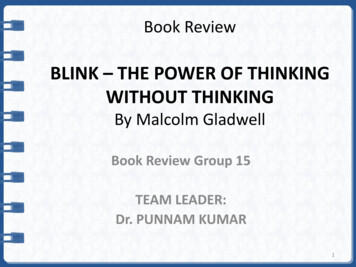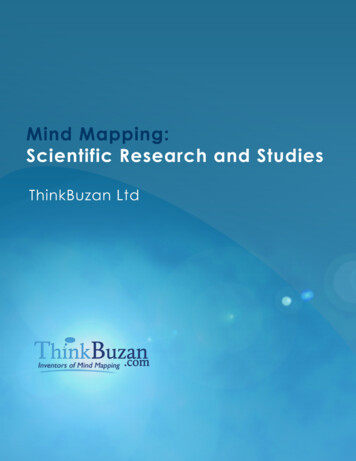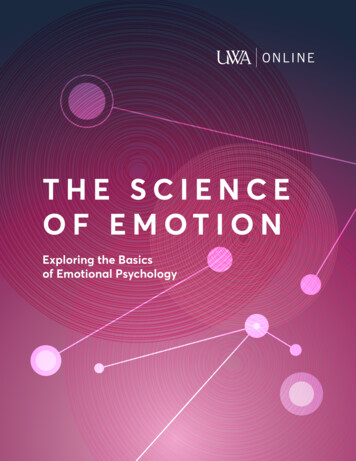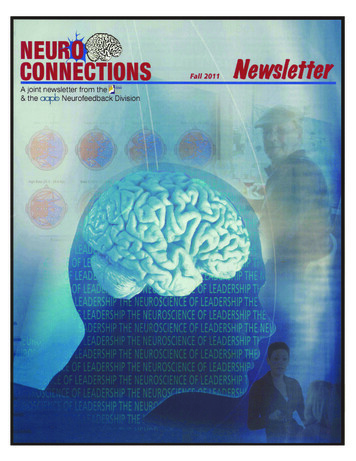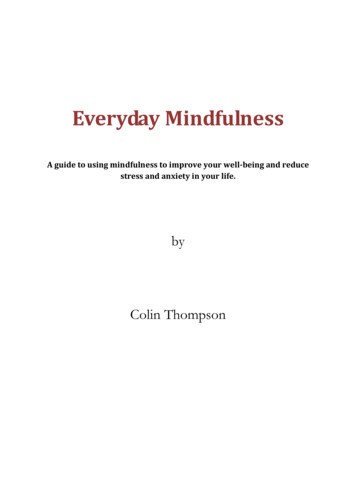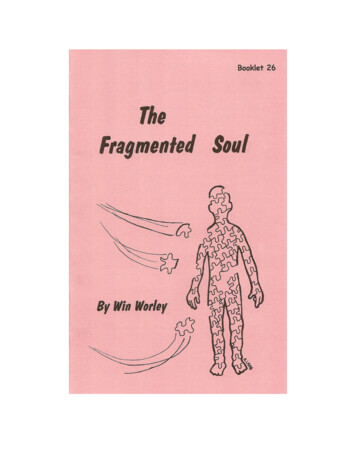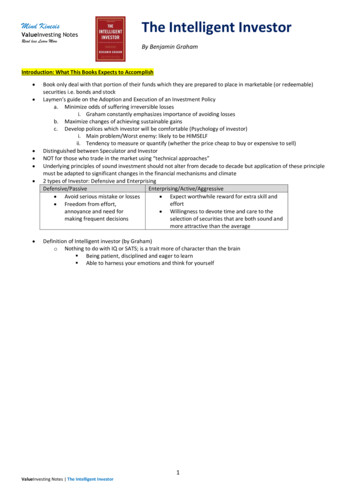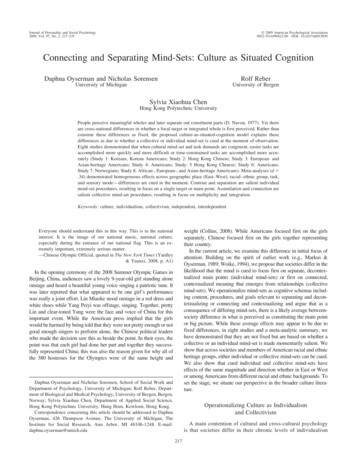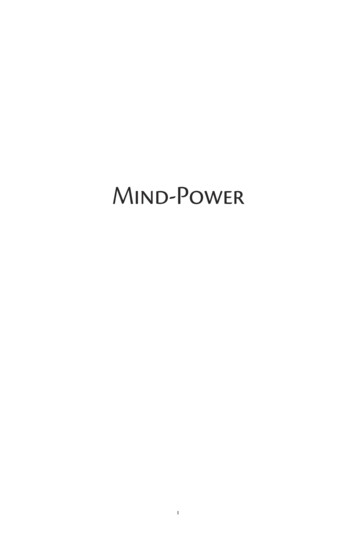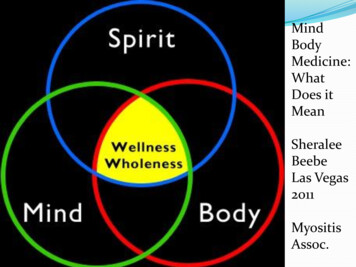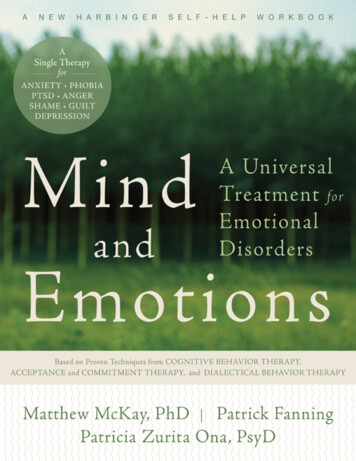
Transcription
In Mind and Emotions, Matthew McKay, Patrick Fanning, and Patricia Zurita Onaprovide invaluable information for people experiencing difficulties regulating theiremotions. Not only will readers learn about the factors contributing to their ongoingpain, but they’ll also learn practical skills for improving their ability to manage theseintense emotions. I love the fact that these authors were able to reflect real-lifepsychotherapy by taking an eclectic approach to the treatment of emotion dysregulation.—Sheri Van Dijk, MSW, RSW, psychotherapist in Ontario, Canada,and author of The Dialectical Behavior Therapy Skills Workbook forBipolar Disorder, Don’t Let Your Emotions Run Your Life for Teens,and The Bipolar Workbook for TeensThis concisely written book offers well-developed, practical tools for readers intent onattending to their emotional needs. There is indeed a synergy in combining the best ofcognitive behavioral therapy, dialectical behavior therapy, and acceptance andcommitment therapy—it’s an approach that promises to help readers pursue a purposefullife.—Patricia J. Robinson, PhD, health care consultant and coauthor ofThe Mindfulness and Acceptance Workbook for Depression and RealBehavior Change in Primary CareMany self-help books offer tips and suggestions on how to cope with only onechallenging emotion, such as anxiety or depression. Unfortunately, anxiety anddepression go together, and most of us who struggle in dealing with one emotion havedifficulties in managing others as well. This new and impressive workbook by McKay,Fanning, and Zurita Ona provides a welcome alternative to having to buy and followseparate books for each specific emotional difficulty you may encounter in life. Mind andEmotions will guide you through an easy-to-follow set of skills designed to put you,rather than your emotions, back in charge of your life.—Robert D. Zettle, PhD, professor of psychology at Wichita StateUniversity in Wichita, KS, and author of ACT for DepressionMind and Emotions provides a wide range of strategies and exercises for changing thebehaviors and thoughts that contribute to uncomfortable feelings such as anxiety,depression, anger, and shame. This book is practical, well-written, and packed withhelpful advice.—Martin M. Antony, PhD, ABPP, professor of psychology at RyersonUniversity in Toronto and author of The Shyness and Social AnxietyWorkbookAt last! Here’s your chance to clear the clutter off your shelves and get rid of all thoseother self-help books that don’t work. McKay, Fanning, and Zurita Ona have put
together a single, effective treatment for multiple forms of emotional pain. Based onresearch and years of success, Mind and Emotions is sure to be the one book people willturn to for help.—Jeffrey C. Wood, PsyD, clinical psychologist, coauthor of TheDialectical Behavior Therapy Skills Workbook, and author of TheCognitive Behavioral Therapy Skills Workbook for PersonalityDisordersMind and Emotions offers a clear and practical entry into the complex and oftenconfusing world of emotions and emotional pain. The authors are experts in the field ofmental health and psychotherapy, and it shows in this work. Their accessible and easyto-follow practices will empower and promote emotional healing for anyone who takesthe time to work through this excellent program.—Jeffrey Brantley, MD, consulting associate in the Duke Departmentof Psychiatry, author of Calming Your Anxious Mind, and coauthor ofDaily Meditations for Calming Your Anxious Mind and the Five GoodMinutes seriesWith compassion and clarity, the authors present a universal approach to the universalpain and suffering that accompanies mental health problems. Readers will find much inMind and Emotions to calm the emotional storms that are barriers to living life fully andpassionately.—Michael A. Tompkins, PhD, San Francisco Bay Area Center forCognitive Therapy and University of California, Berkeley, and authorof Digging OutThis book is beautifully written in simple, clear, and precise language. In very short,highly informative chapters, the best-known techniques for leaning to manage painfulemotions are described and then a range of concrete strategies for practicing thesestrategies is presented. This book can not only be used as part of a self-help program,but also as part of an emotion management skills training group or as an adjunct toindividual counseling for emotion management difficulties.—Kirk Strosahl, PhD, author of Real Behavior Change in PrimaryCareMind and Emotions draws thoughtfully on a transdiagnostic perspective and a triad ofevidence-based treatments for emotional problems. Beyond its self-help value to thepublic, this unique workbook constitutes a rich resource for practitioners seeking toenhance their therapeutic effectiveness.—Thomas F. Cash, PhD, Professor Emeritus of Psychology at Old
Dominion University and author of The Body Image WorkbookThe tools described in this book are drawn from the most effective therapies foremotional disorders that are available today. Used consistently, these tools can changeyour life.—Jacqueline B. Persons, PhD, director of the San Francisco Bay AreaCenter for Cognitive Therapy and clinical professor at the Universityof California, Berkeley
Publisher’s NoteThis publication is designed to provide accurate and authoritative information in regard to the subject matter covered. It is sold with the understanding that the publisher is not engaged in rendering psychological, financial, legal, or otherprofessional services. If expert assistance or counseling is needed, the services of a competent professional should be sought.Distributed in Canada by Raincoast BooksCopy right 2011 by Matthew McKay, Patrick Fanning, and Patricia Zurita OnaNew Harbinger Publications, Inc.5674 Shattuck AvenueOakland, CA 94609www.newharbinger.comCover design by Amy ShoupAcquired by Catharine Mey ersEdited by Jasmine StarAll Rights ReservedPrinted in the United States of AmericaThe Library of Congress has cataloged the print editon as:McKay, Matthew.Mind and emotions : a universal treatment for emotional disorders / Matthew McKay, Patrick Fanning, and Patricia Zurita Ona.p. cm.Includes bibliographical references.ISBN 978-1-60882-015-3 (pbk.) -- ISBN 978-1-60882-016-0 (pdf e-book) 1. Mindfulness-based cognitive therapy. 2. Emotion-focused therapy. 3. Emotions. I. Fanning, Patrick. II. Zurita Ona, Patricia. III. Title.RC489.M55M35 2011616.89’1425--dc222011012638
A Note to eBook ReadersMany of the exercises in Mind and Emotions include instructions for filling out worksheets or writingdown information. In order for you, the ebook reader, to take full advantage of these, we've madePDF versions of all the worksheets in the book available at http://24748.nhpubs.com. You candownload and print these materials to use in conjuction with your reading. You also may find that youcan complete the exercises satisfactorily in a notebook or by using the comment function on yourebook-reading device.
For my students, whose desire to understand human behavior and help those in pain has inspiredme and taught me so much.—MMFor the dedicated teachers, therapists, and researchers upon whose shoulders we stand.—PFFor all those who are willing to try something new despite their pain and struggles.—PZO
Contents1. The Universal Treatment2. The Nature of Emotions3. The Cost of Avoiding Emotions4. Values in Action5. Mindfulness and Emotion Awareness6. Defusion7. Cognitive Flexibility Training8. Self-SoothingMidtreatment Assessment Exercise9. Doing the Opposite10. Interpersonal Effectiveness11. Imagery-Based Emotion Exposure12. Interoceptive Emotion Exposure13. Situational Emotion ExposurePost-treatment Assessment Exercise14. Relapse PreventionReferencesAbout the Authors
Chapter 1The Universal TreatmentThis book is intended for people struggling with emotional pain, and for psychotherapists seeking aneffective treatment for emotional suffering. It offers a universal protocol, meaning that these sametreatment steps are effective regardless of the particular emotion that distresses you. It will help youwith feelings of anxiety, depression, anger, shame, or guilt. It will also help if you’re struggling withhigh levels of multiple emotions, a situation referred to as emotion dysregulation.Why Use a Single Treatment for All Emotional Problems?For many years, psychotherapy researchers focused on developing treatments specific to eachemotional disorder. There were individual treatments for the six main anxiety disorders, several fordepression, and several for anger, as well as protocols for guilt and shame. All in all, researchersdeveloped more than two dozen treatment regimens for emotional disorders.This profusion of treatments had good and bad aspects. On the good news front, psychologicalscience had developed multiple research-based protocols that had been proven effective. Theyhelped people and changed lives. The bad news can be summarized as follows:People with comorbidity (more than one emotional problem) had to undergo more than onetreatment. Treatments were often done sequentially, so therapy for one problem might be delayeduntil another emotional problem was addressed.Skills developed to cope with a particular emotional problem often couldn’t be applied toothers. So, for example, if you underwent a successful treatment for social anxiety in yourtwenties, that wouldn’t have given you the tools you’d need to cope with depression in yourthirties.It was hard to evaluate which of the research-based treatments available for a particularproblem would work best for a given individual. Each treatment is based on a slightly differenttheory of what causes the problem, but almost no research has been done on matching treatmentsto an individual’s traits, characteristics, or typical ways of coping. So we didn’t know muchabout what works for whom.Most of the protocols for emotional disorders were focused on symptoms and symptomreduction. They didn’t address the common underlying factors that create and maintain allemotional disorders. Called transdiagnostic factors (TDFs), these can be understood asdysfunctional coping strategies that start out as attempts to manage stress but backfire and end upcreating severe emotional pain. A treatment that targets TDFs—the cause of emotional problems—may be more effective than those focused solely on symptoms. (More on TDFs later.)These problems were solved with the development of treatments that simultaneously target allemotional problems. Instead of focusing on symptoms, which are clearly different for each emotion,new treatments targeted the underlying causes of all negative emotions—causes such as avoidance,rumination, masking, and negative appraisals. We’ll discuss these causes in detail in chapter 2, TheNature of Emotions.
New Research: Universal Treatments for Emotional ProblemsThere are currently three research-based universal treatments for emotional disorders. The first isdialectical behavior therapy (DBT; Linehan 1993), which focuses on the following key skills forovercoming emotional problems:Mindfulness and acceptanceDistress toleranceSelf-soothingDoing the oppositeEmotion regulationInterpersonal effectivenessThe second is acceptance and commitment therapy (ACT; Hayes, Strosahl, and Wilson 1999),which aims to build psychological flexibility by developing skills in the following areas:MindfulnessObserving and accepting emotionsDefusion (observing and distancing from thoughts)Values-based committed actionA third universal protocol emerged from cognitive behavioral therapy (CBT; Moses and Barlow2006; Allen, McHugh, and Barlow 2008). It emphasizes the following skills:MindfulnessEmotion awareness and acceptanceCognitive restructuringChanging emotion-driven behaviorsEmotion exposureThe effectiveness of each of these therapies is supported by strong research evidence fromnumerous randomized controlled trials. All three have been proven to help people struggling withoverwhelming emotions. As to the question of which is better, we don’t know. Very little research hasevaluated these treatments in head-to-head trials. However, comparing and measuring which of thesetherapies has the best outcomes may not be terribly important, for three reasons:It may take years to get conclusive answers, if the data ever becomes clear.There is significant overlap between the three treatment programs. All include mindfulobservation of experience, some form of emotion acceptance, and exposure exercises to helppeople face difficult emotions. Each protocol has methods for changing how people relate totheir thoughts, thereby making negative thinking less believable. And each treatment helpspeople learn how to steer away from emotion-driven behaviors, which only make emotional
pain worse, and take more effective action instead.The treatment components that are unique to a particular protocol—self-soothing, doing theopposite, and interpersonal effectiveness in DBT, and defusion and values-based action in ACT—can be added to the common components to create a single universal treatment. There’s noreason to have a horse race to see which therapy is better. We can combine them.So here’s the bottom line: These therapies work, and the combined protocol presented in this bookworks. You don’t have to learn individual and sometimes complex treatments for each emotionalproblem you face. You can work your way through a single set of steps and get help with any and allemotions.In this book you’ll find the common elements of all three universal protocols, plus the mosteffective unique components of each. These are the topics covered in chapters 4 through 13, and theyoffer the best help that cutting-edge research has discovered:Values in ActionMindfulness and Emotion AwarenessDefusionCognitive Flexibility TrainingSelf-SoothingDoing the OppositeInterpersonal EffectivenessImagery-Based Emotion ExposureInteroceptive Emotion ExposureSituational Emotion ExposureHow to Use This BookBefore beginning the ten treatment chapters, you need basic information about how much your difficultemotions are affecting you right now, how emotions work, and how you get into emotional trouble. Sodo the exercise at the end of this chapter, and then read chapters 2 and 3 before doing anything else.The exercise at the end of this chapter will help you establish a baseline score for how muchdifficulty you’re having with emotion regulation right now.In chapter 2, The Nature of Emotions, you’ll learn to identify the four components of an emotionalresponse. Developing the ability to observe a problematic emotion is the first step toward regulatingthat emotion. Later in chapter 2 we’ll introduce you to seven transdiagnostic factors that underlieemotional disorders. Each of these TDFs is a coping strategy that attempts to provide immediaterelief from emotional pain, but in the long term all of them only intensify emotions and make the painworse. We provide a questionnaire to help you identify which TDFs are having the greatest influenceon your emotional life. It’s quite possible that you don’t use all of these problematic coping strategies.If that’s the case, you may wish to skip chapters that target a TDF that isn’t relevant to you. Byassessing your use of TDFs, you can tailor this program to your own needs.Chapter 3, The Cost of Avoiding Emotions, helps build your motivation for working with andsticking to this program. You’ll learn to recognize the many faces of avoidance and assess the costs of
each. Avoidance takes a huge toll on your life and vitality, and paradoxically, it also intensifies thevery emotions you’re trying to get away from. In chapter 3 we’ll also discuss the benefits of improvedemotion regulation. The payoffs can be dramatic, so it’s worth it to know the benefits beforebeginning the program (and this will probably also help with motivation).Chapters 4 through 13 are the treatment chapters. Work your way through these in order, but feelfree to skip any that target TDFs you aren’t struggling with. However, do read and work throughchapter 4, Values in Action, chapter 5, Mindfulness and Emotion Awareness, and chapters 11 through13, on emotion exposure, regardless of the TDFs you use. They’re critical to learning emotionregulation and essential for everyone. Also, be sure to fill out the Difficulties in Emotion RegulationScale (DERS; Gratz and Roemer 2004) halfway through your work with this book and again at theend of the emotion exposure chapters. This will give you an objective measure of how your emotionregulation skills are improving.The last chapter, Relapse Prevention, is also vital. You need to know how to recognize the signsthat emotional problems are reemerging and have a specific plan for what you’ll do about it. Thiswill keep you from slipping back into old, ineffective patterns.How to Work This ProgramJust reading about emotion regulation skills isn’t enough. You can only master them by doing theexercises in this book and putting them into practice in your daily life. Changing your experience withoverwhelming emotions starts with changing your behavior—how you think and how you act. Castingaside your old coping responses—the TDFs—is essential to creating a new life and a newrelationship to your emotions.We’ll be with you every step of the way, showing you the path, coaching you, and giving youexamples of how others have succeeded. We’ll offer helpful strategies and step-by-step guidance, andalso provide answers to many of your questions. We admit it: Working this program is work. But ifyou do the work and change your old avoidance patterns, a lot of your emotional pain will fall awayand become just a memory. The research-tested approaches in this program can open the door to anew life.We encourage you to start now, with the following exercise. The Difficulties in Emotion RegulationScale (DERS; Gratz and Roemer 2004) will establish a baseline measurement of how much yourdifficult emotions are affecting you today. Halfway through your work with this book, you’ll fill outthe DERS again to assess your progress, and then at the end of the book you’ll fill out the DERS onelast time, to discover how far this journey has taken you. Pick up your pen, open the door to yourfuture, and begin the changes you’ve been yearning for.Difficulties in Emotion Regulation Scale (DERS)
Please indicate how often the following statements apply to you by writing the appropriate numberfrom the scale below on the line beside each item.1. I am clear about my feelings.2. I pay attention to how I feel.3. I experience my emotions as overwhelming and out of control.4. I have no idea how I am feeling.5. I have difficulty making sense out of my feelings.6. I am attentive to my feelings.7. I know exactly how I am feeling.8. I care about what I am feeling.9. I am confused about how I feel.10. When I’m upset, I acknowledge my emotions.11. When I’m upset, I become angry with myself for feeling that way.12. When I’m upset, I become embarrassed for feeling that way.13. When I’m upset, I have difficulty getting work done.14. When I’m upset, I become out of control.15. When I’m upset, I believe that I will remain that way for a long time.16. When I’m upset, I believe that I will end up feeling very depressed.17. When I’m upset, I believe that my feelings are valid and important.18. When I’m upset, I have difficulty focusing on other things.19. When I’m upset, I feel out of control.20. When I’m upset, I can still get things done.21. When I’m upset, I feel ashamed at myself for feeling that way.22. When I’m upset, I know that I can find a way to eventually feel better.23. When I’m upset, I feel like I am weak.24. When I’m upset, I feel like I can remain in control of my behaviors.25. When I’m upset, I feel guilty for feeling that way.26. When I’m upset, I have difficulty concentrating.27. When I’m upset, I have difficulty controlling my behaviors.28. When I’m upset, I believe there is nothing I can do to make myself feel better.29. When I’m upset, I become irritated at myself for feeling that way.30. When I’m upset, I start to feel very bad about myself.31. When I’m upset, I believe that wallowing in it is all I can do.32. When I’m upset, I lose control over my behavior.
33. When I’m upset, I have difficulty thinking about anything else.34. When I’m upset, I take time to figure out what I’m really feeling.35. When I’m upset, it takes me a long time to feel better.36. When I’m upset, my emotions feel overwhelming.(Copyright 2004 by Kim L. Gratz, Ph.D., and Lizabeth Roemer, Ph.D. Used with permission.)Scoring: Put a minus sign in front of your rating numbers for these items: 1, 2, 6, 7, 8, 10, 17, 20, 22,24, and 34. Then sum up all your ratings, adding the positives and subtracting the negatives, and writethe result here: .This number represents how much your upsetting feelings are affecting your life today, at thismoment. This is a baseline figure, so the exact number isn’t very significant. What’s more important isthe difference between this number and your score when you do this exercise again, halfway throughyour work with this book, and your score after you’ve finished the treatment chapters of the book. Asyou gradually acquire emotion regulation skills, your score will decrease.
Chapter 2The Nature of EmotionsThis chapter examines how emotions work and how they help us survive. It will also give you thetools to observe your emotions and identify the four components of an emotional response. Thisknowledge will help you recognize how emotions turn into behavior and give you a moment of choicein deciding whether to act on emotion-driven urges.Unfortunately, the ability to observe and understand emotions isn’t enough to achieve emotionregulation. You’ll have to go one step further and learn to identify the seven dysfunctional copingstrategies that fuel negative emotions and trap you in patterns of chronic anxiety, anger, or depression.As mentioned in the introduction, these seven ineffective coping responses are sometimes calledtransdiagnostic factors because they underlie—and, in fact, cause—emotional disorders.How Emotions WorkIn the course of human evolution, emotions developed for a specific purpose: to spur us towardactions that help us survive. Negative emotions are a signal that something is wrong or threateningand push us to cope. Anxiety pushes us to avoid dangerous situations. Anger drives us to fight backagainst threats, damage, and hurt. Sadness encourages us to slow down and withdraw, to seek quiettime for processing a loss, or to recalibrate our efforts after a failure. Shame demands that we hideand stop doing what might result in disapproval.The point is, emotions are useful. They help us change course as we face new problems or newcircumstances. They help us adapt to curve balls that threaten to destabilize our lives—or even endthem.Here’s another key point: Emotions, no matter how intense or upsetting, all have a natural life span.If you watch carefully, you’ll observe that all feelings develop like a wave. They rise, crest, andfinally recede, and they’re time limited. Seeing an emotion as a wave can help you wait it out, ratherthan getting swept up in emotion-driven behavior.When you’re in the middle of an intense feeling, sometimes it seems as if it will go on forever. Thisis an illusion created by the strength of the emotion, and sometimes by efforts to resist or suppress thefeeling. You have multiple emotions each day, and many thousands over the course of your life. Everyemotion will end or morph into something else. Learning to be patient, to watch that process, is one ofthe key skills you’ll gain from this book.We humans can’t control emotions, meaning we can’t stop them or get rid of them with an act ofwill. An extraordinary wealth of scientific research has revealed that attempts to suppress, numb, orpush away emotions usually fail. What we resist persists. Feelings we attempt to suppress simply goon longer, and often turn into chronic emotional disorders.To understand how suppression exacerbates and intensifies an emotion, consider the case of aviolinist in a volunteer community orchestra who had surges of anxiety during several performances.His response was to do everything possible to control the feeling, including constantly watching forthe first signs of sweating or a rapid heartbeat. But the effort not to feel anxious only focused hisattention on the symptoms of fear. If he detected any sensations that might indicate fear, he tried tocontrol the experience through avoidance—to the point where he started to think he wouldn’t be able
to perform if he felt fear—and that was a really scary and upsetting thought. The more he paidattention to his body and watched for anxiety during a performance, the greater his fear became. Soremember: You can’t stop emotions, and some efforts to control them will only make them worse.Components of an Emotional ResponseAn emotional response is a lot more than a mood state or a feeling. It has four components, and it’simportant to understand and recognize each of them: affect, emotion-driven thoughts, physicalsensations, and emotion-driven behavior.AffectThe most obvious part of an emotion is the affect: your conscious, subjective experience of thefeeling itself, apart from bodily changes. The affect is what people commonly label as “sadness,”“fear,” “anger,” and so on. Affect is generated in the limbic area of the brain and produces whatpsychologists call a drive state—an urge to some kind of action, such as withdrawal, flight, oraggression. Negative emotions create a sense of distress and disequilibrium—a sense that thingsaren’t right and need to be fixed. The affect part of these emotions is designed to get our attention, tomake us realize that there’s a threat or an imbalance that requires action.Emotion-Driven ThoughtsThe second component of an emotional response is what happens cognitively: thoughts about asituation in which we find ourselves or about the emotion itself. Thoughts during an emotionalresponse tend to fall into two categories: prediction and judgment. Prediction is an attempt to peerinto the future and see what dangers might lie there. Predictive thoughts usually ask the question“What if?”: “What if I lose my job?” “What if the pain in my stomach is a tumor?” “What if my sondoesn’t get into college?” Predictions prepare us for what might happen, but they also have the effectof triggering anxiety as we attempt to solve a problem that hasn’t even occurred—and may not everoccur.Judgments can be directed toward the self or others. When they’re directed toward the self,judgmental thoughts produce sadness and depression. When they’re directed toward others, they tendto trigger anger. Either way, a judgment conveys a belief that the object of that judgment is wrong,bad, mistaken, and somehow guilty of breaking the rules for reasonable living.Emotion-based thoughts are part of a feedback loop that can both trigger and intensify affect.Predictions and judgments can literally create emotions, and then the surging feelings that result canproduce a new flurry of negative thoughts that further escalate the emotion.Physical SensationsEvery emotion has a physiological component. Emotions are felt in the body. Anxiety elevates yourheart rate, speeds up your breathing, and can make you sweat, shake, and tense your muscles.Depression generates feelings of heaviness, torpor, and exhaustion. Anger produces sensations ofheat, along with tension in your arms and legs as you get ready to fight. Shame produces a feeling of
being flushed, weak, and sometimes almost paralyzed.Like emotion-based thoughts, the physical sensations that accompany each emotion can contributeto a feedback loop that strengthens the affect. For example, the palpitations and sweating thataccompany anxiety seem to make feelings of fear worse. You say to yourself, “My heart’s poundinglike a trip-hammer. I must be scared as hell,” and the fear intensifies.Emotion-Driven BehaviorThe last component of an emotional response is the action urge. Action urges always accompanyfeelings. Anxiety makes you want to avoid. Depression makes you want to withdraw. Anger makesyou want to be aggressive. Shame and guilt make you want to hide.When you let yourself act on emotion-driven urges, they fuel the emotion rather than regulate yourfeelings. While there is some survival value to these urges, engaging in emotion-driven behaviorsfrequently tends to convert episodic emotional experiences into chronic problems. There is abundantresearch showing the more you avoid anxiety, the more anxious you become (Eifert and Forsyth2005), and withdrawing when you’re sad makes depression worse (Zettle 2007). There are alsostudies showing that the more aggressive your response to anger is, the more easily you’ll get angry(Tavris 1989). So emotion-driven behaviors may help you cope with difficult things in the short term,but if you engage in them habitually, they play a huge role in emotional disorders.Exploring Your Emotional ResponsesNow it’s time to explore your own emotional responses. The following Emotional ResponseWorksheet will help you separate your feelings into the four components just discussed: affect (theemotion), emotion-driven thoughts, physical sensations, and emotion-driven behaviors. Over the nextweek we’d like you to use this worksheet to identify and clarify your emotions. Make copies of theworksheet and keep one with you at all times, leaving the version in the book blank so you can makemore copies as needed (you’ll use this worksheet in th
Many self-help books offer tips and suggestions on how to cope with only one challenging emotion, such as anxiety or depression. Unfortunately, anxiety and depression go together, and most of us who struggle in dealing with one emotion have difficulties in managing o

